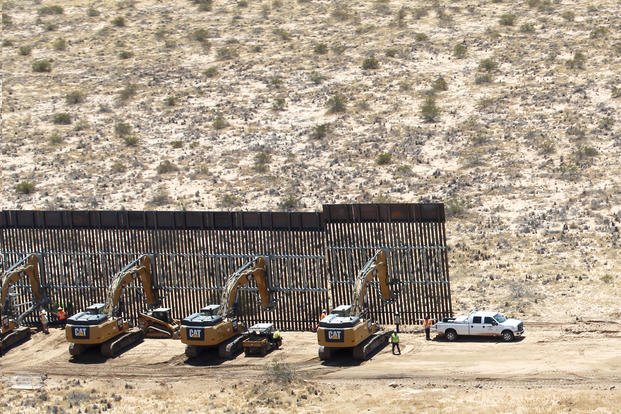The Pentagon recently asked Congress to shift $200 million in funding — originally allocated for projects such as barracks, aircraft hangars and military-operated elementary schools — to construct a roughly 20-mile-long, 30-foot-high barrier across the U.S.-Mexico border in Arizona.
The proposed wall would replace a smaller mesh barrier at a desert training complex adjacent to the border known as the Barry M. Goldwater Range, or BMGR, a 1.9 million-acre training area shared between the Air Force and Marine Corps, according to a letter the Pentagon sent to Congress on May 28.
Defense Secretary Pete Hegseth said that construction of the permanent barrier, replete with gates and a patrol lane, was “necessary to obtain full operational control of the border,” adding that the civilian heads of the Army, Navy and Air Force deemed the project “vital to national security,” according to the letter.
Read Next: Buffalo Soldiers Would Get Highest Congressional Honor Under Senate Proposal
The request splits the cost between the Department of Defense, Navy, Air Force and Army — which also uses the range — in $50 million increments from funding appropriated as far back as fiscal 2021.
The letter characterized the relocation of funding as “savings” from projects the Pentagon estimated cost less than their original appropriation. This practice, known as reprogramming, involves the Pentagon asking for congressional approval to shift money that lawmakers originally allocated for specific military programs elsewhere.
For example, it is requesting more than $11 million from a Marine barracks complex and bachelor enlisted quarters at Kadena Air Base in Japan for the BMGR project. The Pentagon is also seeking to reallocate millions from an F-35 Lightning II hangar in California; a V-22 Osprey airfield in Virginia; and tens of millions of dollars from two military-run elementary schools, one in Germany and the other in Kentucky.
Military.com reported in May that the Pentagon was reallocating $1 billion meant for Army barracks to fund troop deployments to the U.S.-Mexico border as the military becomes increasingly involved in immigration enforcement under President Donald Trump’s administration.
In 2023, Luke Air Force Base, Arizona, which owns part of the BMGR, said in a report that, “as a result of its proximity to the U.S.-Mexico border, the entire BMGR is potentially subject to the presence of undocumented aliens and smuggling traffic,” and was therefore patrolled by U.S. Customs and Border Protection agents.
A representative for the Pentagon acknowledged Military.com’s questions about BMGR on Monday, to include whether such border crossing traffic was the impetus for the shifting of funds, but did not respond by publication.
Earlier this month, the Pentagon requisitioned 140 miles of federal land in Arizona, including near BMGR, as part of its sweeping effort to militarize areas of the border to prevent crossings under Trump’s immigration crackdown.
Related: Pentagon Again Expanding Military Border Zones, This Time in Arizona
Story Continues
Read the full article here

